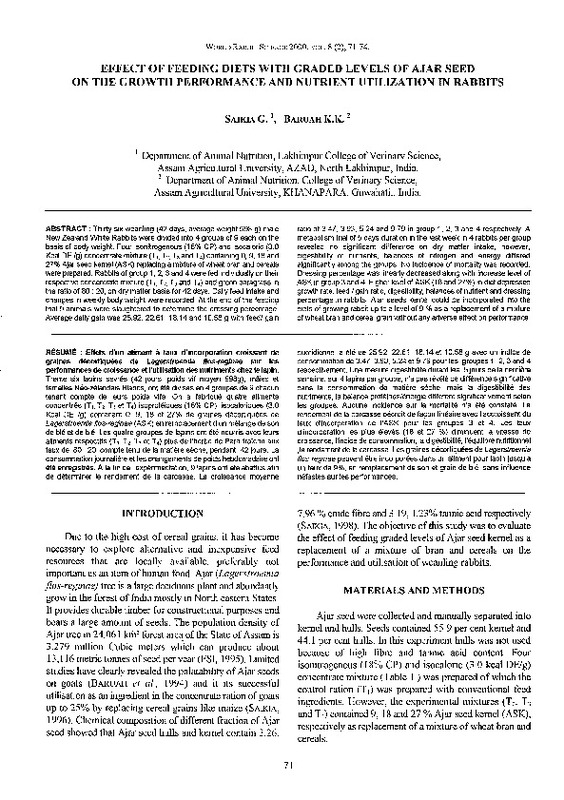JavaScript is disabled for your browser. Some features of this site may not work without it.
Buscar en RiuNet
Listar
Mi cuenta
Estadísticas
Ayuda RiuNet
Admin. UPV
EFFECT OF FEEDING DIETS WITH GRADED LEVELS OF AJAR SEED ON THE GROWTH PERFORMANCE AND NUTRIENT UTILIZATION IN RABBITS
Mostrar el registro sencillo del ítem
Ficheros en el ítem
| dc.contributor.author | Saikia, G.
|
|
| dc.contributor.author | Baruah, K.K.
|
|
| dc.date.accessioned | 2011-03-09T08:09:26Z | |
| dc.date.available | 2011-03-09T08:09:26Z | |
| dc.date.issued | 2000 | |
| dc.identifier.issn | 1257-5011 | |
| dc.identifier.uri | http://hdl.handle.net/10251/10232 | |
| dc.description.abstract | [EN] Thirty six weanling (42 days, average weight 998 g) male New Zealand White Rabbits were divided into 4 groups of 9 each on the basis of body weight. Four isonitrogenous (18% CP) and isocaloric (3.0 Kcal DE /g) concentrate mixture (T1. T2. T3 and T4) containing O, 9, 18 and 27% Ajar seed kernel (ASK) replacing a mixture of wheat bran and cereals were prepared. Rabbits of group 1, 2, 3 and 4 were fed individually on their respective concentrate mixture (T1. T2. T3 and T4) and green paragrass in the ratio of 80 : 20, on dry matter basis for 42 days. Daily feed intake and changes in weekly body weight were recorded. At the end of the feeding tria! 9 animals were slaughtered to determine the dressing percentage. Average daily gain was 25.92, 22.61, 18.14 and 10.58 g with feed/ gain ratio of 3.47, 3.93, 5.24 and 9.79 in group 1, 2, 3 and 4 respectively. A metabolism tria! of 5 days duration in the last week in 4 rabbits per group revealed no significan! difference on dry matter intake, however, digestibility of nutrients, balances of nitrogen and energy differed significantly among the groups. No incidence of mortality was recorded. Dressing percentage was linearly decreased along with increase level of ASK in group 3 and 4. Higher level of ASK (18 and 27%) in diet depressed growth rate, feed I gain ratio, digestibillty, balances of nutrient and dressing percentage in rabbits. Ajar seeds kernel could be incorporated into the diets of growing rabbit up to a level of 9 % as a replacement of a mixture of wheat bran and cereal grain wlthout any adverse effect on performance | es_ES |
| dc.description.abstract | [FR] Trente six lapins sevrés (42 jours, poids vif moyen 998g), males et femelles Néo-zélandais Blancs, ont été divisés en 4 groupes de 9 chacun tenant compte de leurs poids vifs. On a fabriqué quatre aliments concentrés (T1. T2, T3 et T4) isoprotéiques (18% CP), isocaloriques (3.0 Kcal DE /g) contenant O, 9, 18 et 27% de graines décortiquées de Lagerstroemia flos-reginae (ASK) en remplacement d'un mélange de son de blé et de blé. Les quatre groupes de lapins ont été nourris avec leurs aliments respectifs (T1, T2, T3 et T4) plus de l'herbe de Para fraiche aux taux de 80 : 20, compte tenu de la matiére séche, pendan! 42 jours. La consommation journaliére et les changements de poids hebdomadaire ont été enregistrés. A la fin de l'expérimentation, 9 lapins ont été abattus afin de déterminer le rendement de la carcasse. La croissance moyenne quotidienne a été de 25.92, 22.61, 18.14 et 10.58 g avec un indice de consommation de 3.47, 3.93, 5.24 et 9.79 pour les groupes 1, 2, 3 and 4 respectivement. Une mesure digestibilité duran! les 5 jours de la derniére semaine, sur 4 lapins par groupe, n'a pas révélé de différence significative dans la consommation de matiére séche, mais la digestibilité des nutriments, la balance protéines/énergie différent significativement selon les groupes. Aucune incidence sur la mortalité n'a été constaté. Le rendement de la carcasse décroit de fac;;on linéaire avec l'accroissent du taux d'incorporation de l'ASK pour les groupes 3 et 4. Les taux d'incorporation les plus élevés (18 et 27 %) diminuent la vitesse de croissance, l'indice de consommation, la digestibillté, l'équilibre nutritionnel ,le rendement de la carcasse. Les graines décortiquées de Lagerstroemia flos-reginae peuvent etre incorporées dans un aliment pour lapin jusqu'a un taux de 9%, en remplacement de son et grain de blé, sans influence néfastes sur les performances. | |
| dc.language | Inglés | es_ES |
| dc.publisher | World Rabbit Science. ICTA. UPV | es_ES |
| dc.relation.ispartof | World Rabbit Science | |
| dc.rights | Reserva de todos los derechos | es_ES |
| dc.title | EFFECT OF FEEDING DIETS WITH GRADED LEVELS OF AJAR SEED ON THE GROWTH PERFORMANCE AND NUTRIENT UTILIZATION IN RABBITS | es_ES |
| dc.type | Artículo | es_ES |
| dc.date.updated | 2011-03-08T12:56:23Z | |
| dc.identifier.doi | 10.4995/wrs.2000.422 | |
| dc.rights.accessRights | Abierto | es_ES |
| dc.description.bibliographicCitation | Saikia, G.; Baruah, K. (2000). EFFECT OF FEEDING DIETS WITH GRADED LEVELS OF AJAR SEED ON THE GROWTH PERFORMANCE AND NUTRIENT UTILIZATION IN RABBITS. World Rabbit Science. 08(2). https://doi.org/10.4995/wrs.2000.422 | es_ES |
| dc.description.accrualMethod | SWORD | es_ES |
| dc.relation.publisherversion | https://doi.org/10.4995/wrs.2000.422 | |
| dc.description.volume | 08 | |
| dc.description.issue | 2 | |
| dc.identifier.eissn | 1989-8886 | es_ES |








